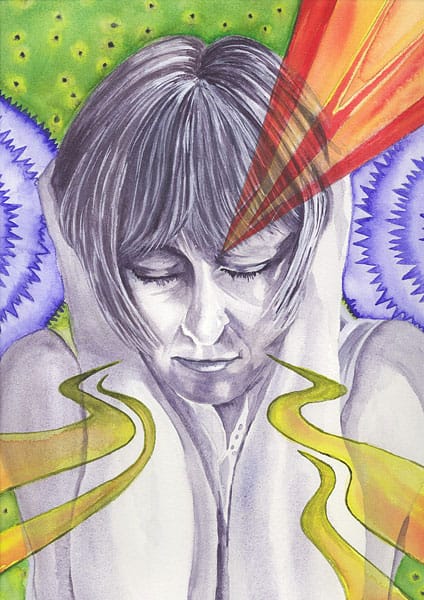As Julia Phillips Smith and I speak, she is in the midst of a migraine attack. "Right now, about halfway down my head, I've got a big, L-shaped crushing feeling; it's like a bear trap on my head and neck, and it goes into my jaw," she says. "I have numbness on my right-hand side; and then inside, in my body, it aches like I've got appendicitis.
"But she's felt worse. Today, despite all those symptoms, Smith is at the office, working away at her "day job" in records management for the Nova Scotia government. Outside office hours, Smith, who lives in Cole Harbour, NS, is a self-published author of dark fantasy and historical romance novels. Her first book, Saint Sanguinus, came out last November.
Smith is one of thousands of Atlantic Canadians who suffer from migraine headaches. Migraine symptoms vary, but a typical migraine might feature intense throbbing, usually - but not always - on one side of the head; they can also include nausea, vomiting, diarrhea, and sensitivity to light, sound and smell. Migraines occur more frequently among women than men (approximately 70 to 75 per cent of migraine suffers are women), and can begin in childhood, adolescence or adulthood. Typically, they last from four to 72 hours.

Before a migraine attack some people experience what's referred to as an "aura" - most often a visual disturbance, but sometimes a sensory, motor or verbal disturbance. Auras generally last from 10 to 30 minutes and can take the form of vision loss or seeing stars, flashes of light or zigzagged lines. Smith says that when she experiences an aura (it doesn't occur with every migraine), there's a prism effect. "It's like you have a suncatcher made out of glass, and what you're looking through is warped, in a jagged circle." Other times, she says, she feels like she's got a bunch of bees underneath her scalp.
Smith's current migraine has been hanging around, waxing and waning, but never entirely disappearing, for almost two weeks now. What's helping her get through her workday is a medication that is a combined Aspirin and analgesic with a barbiturate - what she calls her "big gun" painkiller.
"I don't take it just for fun," she says. "I have to be on the edge of sanity. As soon as I start getting symptoms, I medicate quickly. The quicker the better, and then the easier it is to handle the growth of the migraine."
And as Smith knows all too well, migraines – especially chronic, continuous migraines like hers – are tough to treat.
"There's acute treatment and there's preventative treatment," says Dr. R. Allan Purdy, a neurologist at the QEII Health Sciences Centre, in Halifax, and a professor of neurology at Dalhousie University. "Of the treatments in acute therapy, people start off with simple things like analgesics, ibuprofen, acetaminophen and Aspirin. But they probably won't treat a moderate to severe migraine," he says.
"After that, they have to move up to migraine-specific agents. The ones that have been available for the last 20 years are called the triptans, the most famous of which is sumatriptan, which was the first one. These drugs are highly effective; very specific for migraine attacks. They can constrict blood vessels on the brain surface; they can also stop swelling around the blood vessels and therefore stop the attack."
Dr. Purdy notes that about 70 per cent of the people who use triptans will have a fairly good response within two hours, which means the headache has gone from very severe or moderately severe to mild, or it's largely gone altogether. "That's not bad, but 30 to 40 per cent of people in placebo groups in trials will get the same response," he notes.
On the preventive side, there are drugs that can be taken on a daily basis to reduce the severity or frequency of migraines. "These drugs are very powerful. They're from very different classes - some are anti - seizure drugs, some are blood pressure-like drugs and some are antidepressant-like drugs, although they are not used for depression but for pain," Dr. Purdy says. "Their best benefit is to reduce the number of headache attacks by 50 per cent per month. So if you usually had six attacks, they could take you to three. That would be the best outcome.
"But the real question for patients is, do you want to take a drug every day that only has a benefit of reducing the number of headaches by 50 per cent? Some of these drugs have a lot of side effects, some of which are potentially serious."
Besides, he points out, effective migraine treatment is about more than medication. Dr. Purdy says a key factor in coping with migraines - or any kind of chronic pain - is that patients have a sense of control, and that they take some ownership of the factors that may be influencing their headaches. Maybe, he says, a migraine is telling you something about yourself and your brain; it's a form of reality check.
"Someday, I'm going to write an article called 'Maybe a migraine is good for you,'" he says, with tongue planted firmly in cheek. "Why would I say that? Because if you are somebody with a lot of migraines, you are going to have to learn to live your life in moderation. Don't skip meals. Don't sleep too little. Don't sleep too long. Try to do things normally. Try not to drink too much alcohol. Try not to be too stressed. And guess what happens when people do that? Their headaches are frequently better."
Preventing migraines can also mean avoiding certain foods. Chocolate, dairy products, red wine, foods containing monosodium glutamate (MSG), nuts, onions and meats containing nitrates can all trigger a migraine reaction. In Smith's case, she says she's been tested for all sorts of food triggers, but none has come up positive; she also insists that, apart from staying up late some nights to work on her writing, her life is pretty much a picture of moderation. "I'm actually a very easy going person," she says. "I don't get stressed out."
Lifestyle factors aside, she knows exactly what triggers her migraines - and it's not something she can control. "My trigger is related to weather patterns," she says. "I am a better weather forecaster than the Weather Network, because if a low pressure system is coming in, I will start to feel it.
"I do feel at the mercy of that," she admits. "Having said that, I don't just submit. It's my life and I'm going to figure out some way to do what I want to do, even though I live in a world where the rug gets pulled out from under me pretty constantly."
Unable to take triptans due to a severe allergic reaction, Smith has found success and a measure of relief with an entirely non-pharmacological therapy: acupuncture.
"Right now I'm going every three weeks. When I started, two and a half years ago, I went twice a week and we have been dwindling it down as I'm improving. I used to have a bottle of 60 painkillers for a two-month period. I would force myself to make it last that long, because I didn't want it to stop being effective. That was my greatest fear - that what was working for me would stop working," she says. "Now a bottle of 30 is lasting me four months."
Acupuncture as a treatment for migraines has come under serious scrutiny from the medical community in recent years. A 2009 review of 22 trials concluded that acupuncture is at least as effective as, or possibly more effective than, preventative drug treatment, and has fewer adverse side effects.
Smith says she used to miss at least a half day of work every two weeks, and one of her goals with acupuncture was to change that. "Now," she says, "I don't miss work." She admits, though, that on a day like today, it's still a tough go, because she's always mentally fuzzy during a migraine. "What I'm doing this morning are things that won't take as much concentration for me. I'm still doing work, but I'm not working on anything that I could goof up."
Dr. Purdy says he's optimistic about the future for migraine sufferers - he's even gone so far, in a paper he wrote for the journal Neurological Sciences, to suggest that a cure might someday be possible.
"The research has moved very much forward, partly because now people accept migraine as a neurobiological disorder; it's not a problem of depressed women," he says, admitting that in the past there had been some stigma attached to the disorder. "It's real, not imaginary. It can be moderately to severely debilitating, and it costs the Canadian economy something like $500 million a year in lost time, so this is a major health problem. And even the World Health Organization has put migraine in the top five of the most disabling medical conditions. So it's a big deal."
His advice to patients is to focus on the positives. "There are very helpful and effective therapies - it's in your best interest to be your own advocate."
Smith would agree. "It definitely rules my entire existence, but I fight against it - otherwise you might as well curl up in a ball and not do anything. I definitely push through a lot of things, but it's because I'm stubborn," she laughs. "Mind over matter, that's me."
In her own words
I'll describe a typical migraine for me. Keep in mind that these symptoms have downgraded over the two-and-a-half years I've been going to acupuncture. Now - including tonight - I'd say that, instead of the pain levels being at a boiling point, they're on simmer. You'd still avoid putting your hand on a burner turned to simmer, but it's not red hot.
For the most part, my migraines start as an increased heaviness and numbness on the entire right side of my body. Think dentists' Novocain, and then imagine one half of your body feeling like that.
My migraine sometimes begins with an aura, which, for me, looks like a clear suncatcher or beveled glass. The aura begins as a small bleary visual disturbance and then continues to expand and flash like a marquee sign. It blocks my vision in that eye (all symptoms occur on my right side). In most cases, the visual disturbance is accompanied by nausea. I also get a deep ache in my right lower abdomen, even along with the numbness.
I can't look at anything flashy like commercials, and every sound is painful. In fact, if I shut my eyes I can see a flicking image behind my eyes.
My scalp feels like there are about a dozen bees crawling and buzzing just under my skin.
The middle right side of my head down to my right shoulder, along with my jaw, feels like a bear trap suddenly clamped shut on me; this sensation stays there for the duration of the migraine.
My right eye feels like someone is trying to pop my eyeball out from the inside.
The only thing that happens on the left side is that I start dropping things out of my left hand.
I also have difficulty speaking, rather like a stroke victim.
Throughout all of this, the internal pain level inside my head is severe, as if a hot, heavy piece of shrapnel lodged itself in my brain - and stays there for up to 10 days, sometimes.
~Julia Phillips Smith
